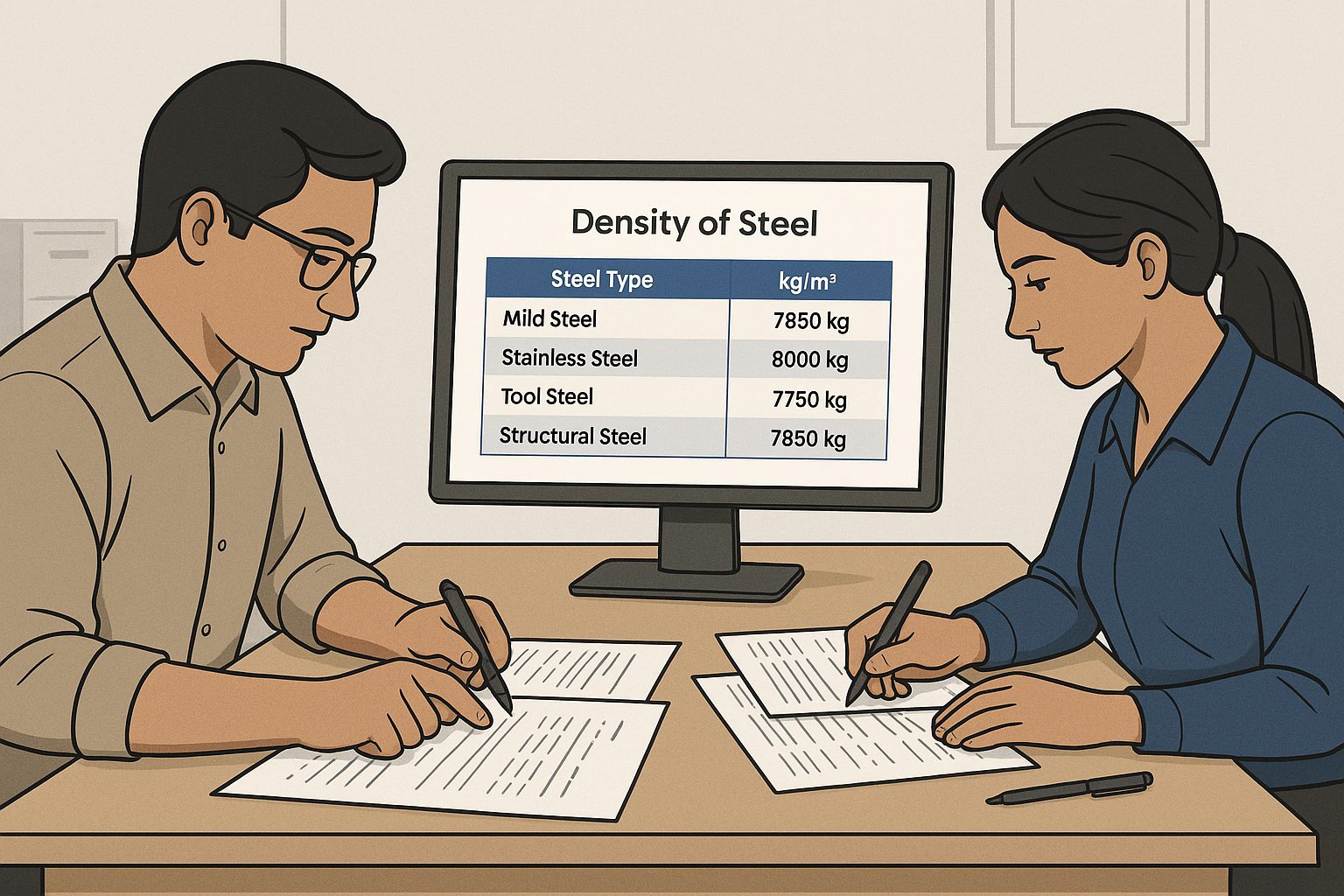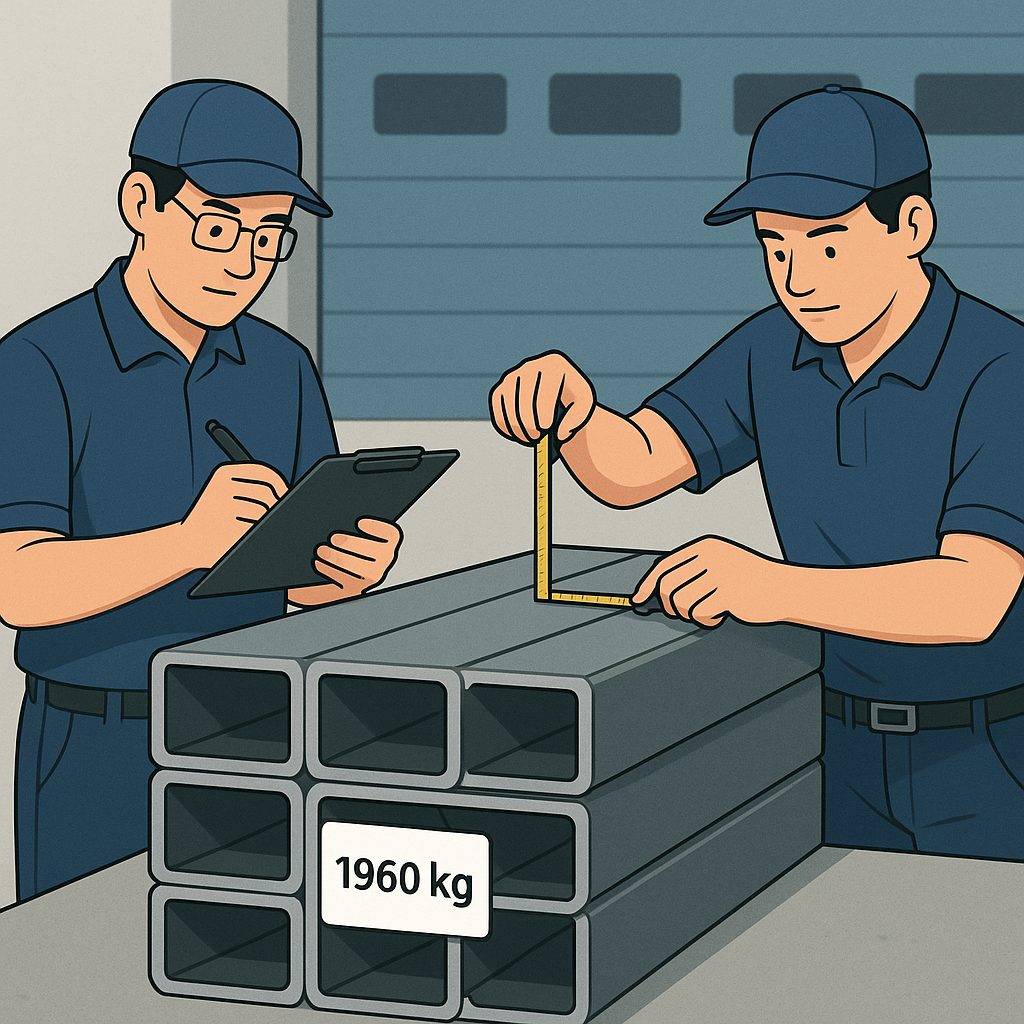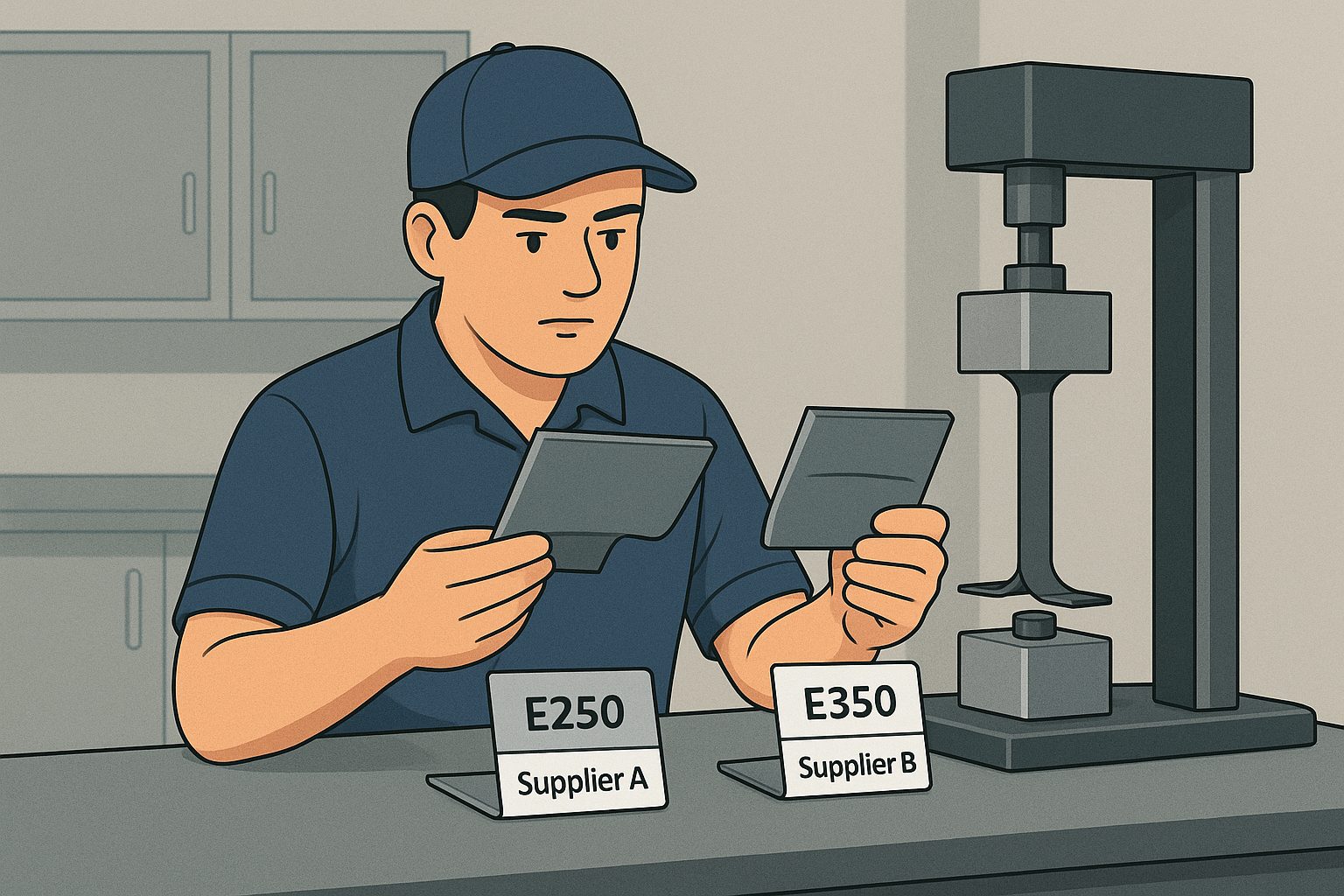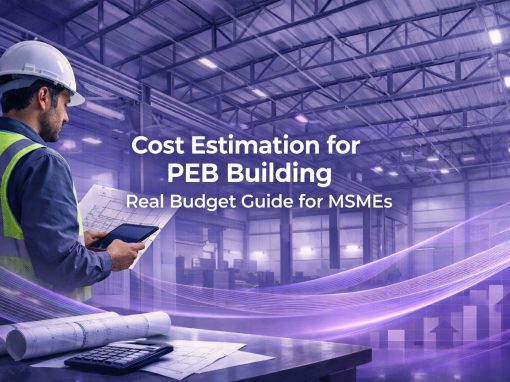Table of Contents
- Introduction
- What Is the Density of Steel and Why It’s Almost Always 7,850 kg/m³
- Why Steel Density Affects MSME Procurement and Costing
- Integrating Density Into Vendor Evaluation and RFQ Templates
- Mild Steel vs Other Grades: Choosing Right for MSME Use-Cases
- Documentation, IS Codes, and Testing Protocols
- Conclusion
Steel procurement decisions aren’t just about the rate per kilogram. Volume matters, and so does the material’s weight per unit. That’s where density enters the picture.
Every type of steel—whether mild, structural, or stainless—has its own density. When that detail is missing or assumed, sourcing teams end up with calculation errors. Freight estimates go wrong. RFQs reflect the wrong total weight. Material take-offs don’t match what’s delivered. And in most MSMEs, no one notices until there’s a mismatch at the godown.
This plays out often in fabrication units. A buyer places an order assuming a uniform density across multiple grades. But the bundles that arrive don’t match the recorded weight. The supplier pushes back, the store team escalates, and finance sits on the payment. Weeks are lost chasing a simple oversight: someone skipped verifying density at the RFQ stage.
It’s not a technical detail—it’s a cost variable. And if it isn’t factored in early, it shows up later as either material shortage, excess freight, or dispute during invoicing.
What Is the Density of Steel and Why It’s Almost Always 7,850 kg/m³
Steel comes in different grades, but the numbers don’t shift much when it comes to weight per volume. Whether you’re buying mild steel flats or structural angles, most grades sit around the same mark: 7,850 kilograms per cubic metre.
That number isn’t just technical — it’s what links size to weight. If you’re quoted in metres, this is how you estimate tonnage. If the quote is in weight, this is how you check if the dimensions line up. Skip it, and you risk overpaying or underordering.
Here’s what most buyers work with:
| Steel Type | Density (kg/m³) | Notes |
| Mild Steel (IS 2062) | 7,850 | Standard for Indian MSMEs |
| Stainless 304 | 7,930–8,000 | Higher due to added nickel/chrome |
| Tool Steel | 7,750–7,950 | Depends on carbon and alloy content |
| Structural Sections | 7,850 | IS 808 profiles; matches MS base |
Most teams just use the 7,850 figure across the board. That’s fine for general buying. But if you’re comparing vendors, or if freight cost matters, you’ll want to confirm the exact value per grade.
Keep this chart in your RFQ format. It avoids disputes and makes your costing more accurate.
Why Steel Density Affects MSME Procurement and Costing
In everyday sourcing, it’s easy to miss the numbers that sit behind the quote. Density is one of them. Not because it’s hidden, but because most teams aren’t trained to factor it into real-world cost. But for MSMEs handling variable grades, irregular volumes, or custom fabrication, the impact shows up fast — in the books, in the yard, or during dispatch.
The Quote May Be Right — But the Math Might Not Be
When suppliers send quotes, they often price per kilogram. But the dimensions provided need to be converted using the correct density to match the weight. If your team assumes the wrong density — even by 100 kg/m³ — the cost projection breaks.
In many RFQs, the mistake isn’t visible. The total price looks fine. But somewhere down the line, your received quantity falls short, or the invoice doesn’t match the PO. That’s not always fraud. Sometimes it’s just a mismatch in the numbers both sides used.
Extra Weight Means Extra Freight — Often Missed in Advance
Transport charges don’t care about grade or supplier quality. They respond to weight. A shipment that’s only slightly denser than planned could tip your freight charges into a higher slab.
This happens more often when MSMEs deal with long-distance suppliers or mixed-grade orders. The material arrives intact, but the transporter hands over a bill that’s 8–12% higher. And because the weight wasn’t cross-checked at the RFQ stage, it becomes a cost you can’t pass on.
Material Yields Drop Without Anyone Noticing
In fabrication, yield is king. One length of steel is expected to produce a certain number of components. But if the steel’s density is lower than expected, your batch output can drop — even when dimensions match.
It’s a silent problem. Fabricators adjust. Floor managers pad orders. But the sourcing team never hears about the 3% drop in actual output. That gap, repeated across cycles, adds up to real loss.
Storage Constraints Don’t Always Announce Themselves
A higher-density batch takes up the same space, but weighs more. For most MSMEs, this matters. Warehouse racks, forklifts, even floor strength — they’re rated to a limit. If that limit is passed without warning, damage follows.
It’s not unusual to see dented beams, bent angles, or forklifts struggling with pallets. When the purchase team flags density upfront, store teams can prep. When they don’t, problems roll in quietly.
Density Is a Cost Variable, Not Just a Physical One
Treating density as a technical detail is a mistake. It belongs alongside price, GST rate, and lead time. It affects landed cost, storage plan, and output efficiency.
For MSMEs with tight cycles and no room for waste, locking this number early is essential. Put it in the RFQ. Review it during quote comparison. Check it again before release of payment. It’s a small step that prevents larger headaches.
Integrating Density Into Vendor Evaluation and RFQ Templates
Some teams treat density like background data. Others don’t mention it at all. But when quotes vary, or deliveries don’t match what’s expected, this one detail is often the missing piece. If you’re working with multiple suppliers, or switching between steel types, it’s smarter to bring density into the discussion early — and keep it there.
Ask for Density Upfront — Don’t Wait for the Discrepancy
When floating an RFQ, include a line asking for the material’s expected density. It takes seconds, but it sets the tone. Now, the supplier knows you’re not just shopping on price — you’re checking inputs. If the quote skips this detail, circle back and ask.
You don’t need lab data. Just a number that lines up with known grades. For example, IS 2062 E250 should be around 7,850 kg/m³. If a vendor lists 7,600 or 8,100, you have something to flag before the PO moves.
Compare Density With What You Already Know
You probably have old GRNs, dispatch notes, or test reports from earlier consignments. Pull them up. If the current quote shows a big gap from the last batch, it’s worth checking why.
Sometimes the material is the same, but a different mill. Other times, it’s a lower-density mix dressed up as a higher-grade supply. A small difference may not matter, but a consistent mismatch is a reason to hold.
Back-Calculate Using Dimensions, Not Just Total Price
If the supplier gives you size and weight, run the numbers. Use the basic steel weight formula. Check if the density implied by the dimensions matches what they say. If it doesn’t, pause the negotiation.
This step isn’t about catching vendors out. It’s about making sure both sides are working from the same numbers. If there’s a mismatch here, there will be problems later — usually at the delivery gate or during invoice clearance.
Keep a Simple Chart for Your Team — Nothing Fancy
You don’t need software. Just a one-page sheet with common grades and their densities: mild steel, stainless, structural profiles. Add notes if you’ve seen suppliers quote odd values in the past.
Share it across teams. If everyone from the buyer to the storekeeper uses the same chart, you avoid confusion later. It also makes internal reviews faster, especially when someone has to approve a borderline quote.
Mention Density in the PO — and Cross-Check on Receipt
Once the order’s placed, include the expected density in your purchase terms. Not hidden in the annexure — put it next to the material spec.
When the steel arrives, pick a random bundle and measure. Use the known size and actual weight to reverse-check the density. If it’s far off, don’t sign the GRN yet. Call the supplier, ask for clarification, and settle it before finance gets involved.
Mild Steel vs Other Grades: Choosing Right for MSME Use-Cases
Not all steel is the same. Some buyers treat it that way, then deal with the consequences later — rejections, rust, machining delays, or parts that don’t hold shape. Choosing the right grade isn’t about price; it’s about fit. And in most MSMEs, that choice happens under pressure.
Mild Steel Does the Job — But Not Every Job
For general work — support frames, basic angles, feeder brackets — mild steel holds up. It bends well, welds without fuss, and costs less. You’ll find it almost everywhere.
But once you step into exposed environments or tight tolerance builds, it’s less forgiving. It rusts if left bare. It flexes under load. If that matters in your assembly, the savings won’t last.
Stainless Steel Isn’t Overkill When Time and Cleanliness Matter
Some jobs aren’t about strength. They’re about surface finish, durability, or zero maintenance. Stainless gives you that. Grades like 304 or 316 stay clean, resist wear, and don’t need coating.
Yes, it costs more upfront. But you skip the primer, skip the repaint, and skip the callbacks. For MSMEs in fabrication or signage, that’s time saved and complaints avoided.
3. High-Strength Grades Cut Material, But Demand Skill
Steel like E350 or E410 gives you strength in less volume. That means thinner sheets, smaller sections, and lower shipping weight. But it’s harder to cut, harder to drill, and not easy to weld unless your shop is set up right.
Don’t switch to it just for savings unless your floor team is briefed. If you burn through blades or ruin edges, the benefit disappears fast.
4. Don’t Chase What the Vendor Has in Stock
This happens more than it should. The vendor says, “I have a similar grade, ready to ship.” The buyer adjusts the spec. Two weeks later, parts don’t fit, or welding fails. Everyone blames the material, but the issue started in sourcing.
Stick to your grade unless you’ve tested the alternative. If stock is tight, wait. Rushing in steel that “should work” leads to problems later — and it’s the plant that pays.
5. Build a Simple Log of What’s Been Used and Why
Keep a working note — just one page. List the grade, the job it was used for, and how it performed. Add problems if they came up. If the sheet cracked, note it. If a batch rusted too early, write that down.
Over time, that note becomes better than any catalogue. It tells you what works in your setup, with your machines, for your customers.
Documentation, IS Codes, and Testing Protocols
Paperwork doesn’t seem urgent — until there’s a shortfall, a grade error, or a payment block. For MSMEs, clean documentation is often the only thing standing between a smooth dispatch and a stalled production line. These checks don’t take long, but skipping them costs more later.
Mention Density and IS Code in the PO
Every purchase order should state material grade, expected density, and the correct IS code. If left vague, it opens the door to mismatched supply.
Use Specific Codes — Not “As Per Standard”
- Mild steel flats: IS 2062
- Structural shapes: IS 808
- HR coils: IS 10748
If a supplier sends a near-match, you’ll need this detail to push back.
Don’t Skip the Test Certificate
Ask for it with every batch. It confirms composition, sometimes strength. No certificate? Hold the payment.
Check Density on Arrival
Measure size. Weigh the piece. Calculate backward. If the density’s off by too much, flag it before the GRN is closed.
Store Everything in Two Places
Print a copy. Keep the digital one. Mark it by vendor and month. If there’s a dispute later, that folder saves time.
Conclusion
Steel is priced in kilograms, but it moves, stores, and performs by volume. That gap matters — especially for MSMEs working with tight margins and short lead times. When density is left out of the RFQ or skipped in verification, mistakes follow: wrong quantities, freight overruns, or grade confusion. It’s not a technical detail. It’s a sourcing variable. Lock it in early. Write it down. Cross-check when it arrives. That one habit keeps cost, compliance, and delivery on track.
Looking to procure steel?
Tata nexarc helps manufacturers, builders and MSMEs source certified steel products, compare prices, and choose the right grade as per IS codes—with complete traceability and procurement confidence.
FAQs
Can two suppliers offer the same grade of steel with different densities?
Does paint or coating affect the density of steel during calculation?
Is density different for hot-rolled and cold-rolled steel?
How do I calculate steel weight if I only have length and section dimensions?
Can incorrect density impact GST or landed cost calculations?
Are density values part of BIS specifications for steel grades?
Should MSMEs verify density when purchasing cut pieces or remainders?
Is density verification mandatory for tender-based supply contracts?
Can density affect how steel is stored or stacked?
Is it necessary to include steel density in third-party inspection reports?
Ananya Mittal blends a background in data science with a passion for writing, contributing to Tata Nexarc’s efforts in creating insightful, data-informed content for MSMEs. Her work focuses on exploring sector-specific challenges and opportunities across procurement, logistics, and business strategy. She is also involved in leveraging analytics to strengthen content performance and deliver actionable insights to India's growing B2B ecosystem.












